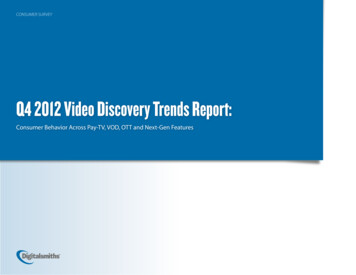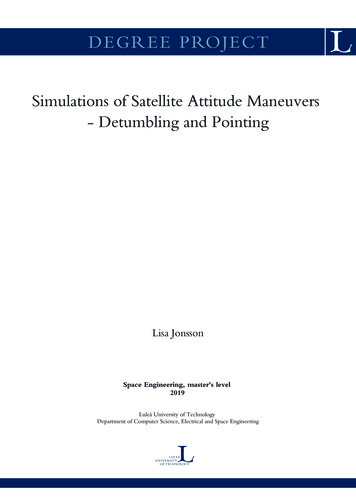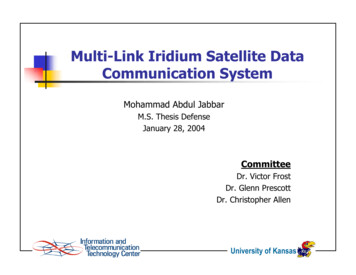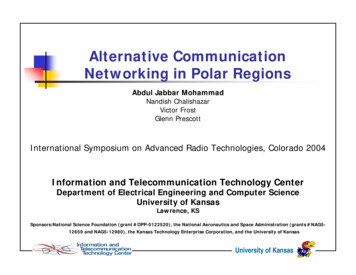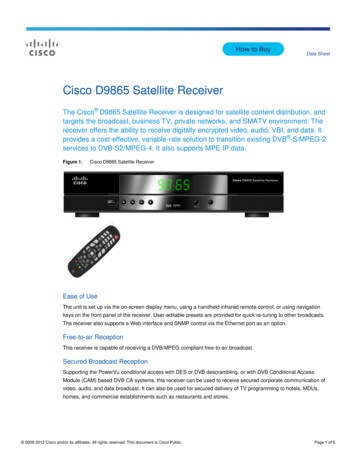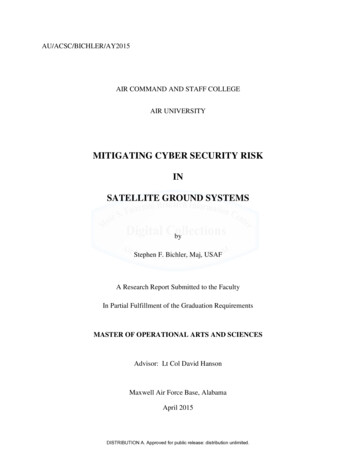
Transcription
EC8094: Satellite CommunicationDepartment of ECEEC8094 - SATELLITE COMMUNICATIONLTPC3 003OBJECTIVES:The student should be made to: Understand the basics of satellite orbits Understand the satellite segment and earth segment Analyze the various methods of satellite access Understand the applications of satellites Understand the basics of satellite NetworksUNIT I SATELLITE ORBITS9Kepler‟s Laws, Newton‟s Law, Orbital Parameters, Orbital Perturbations, Station Keeping, GeoStationary and Non Geo-Stationary Orbits – Look Angle Determination - Limits of Visibility –Eclipse - Sub Satellite Point – Sun Transit Outage - Launching Procedures - Launch Vehiclesand Propulsion.UNIT II SPACE SEGMENT9Spacecraft Technology - Structure, Primary Power, Attitude and Orbit Control, Thermal Controland Propulsion, Communication Payload and Supporting Subsystems, Telemetry, Tracking andCommand – Transponders - The Antenna Subsystem.UNIT III SATELLITE LINK DESIGN9Basic Link Analysis, Interference Analysis, Rain Induced Attenuation and Interference,Ionospheric Characteristics, Link Design with and without Frequency Reuse.UNIT IV SATELLITE ACCESS AND CODING METHODS9Modulation and Multiplexing: Voice, Data, Video, and Analog – Digital Transmission System,Digital Video Broadcast, Multiple Access: FDMA, TDMA, CDMA, DAMA AssignmentMethods, Compression – Encryption, Coding Schemes.UNIT V SATELLITE APPLICATIONS9INTELSAT Series, INSAT, VSAT, Mobile Satellite Services: GSM, GPS, INMARSAT, LEO,MEO, Satellite Navigational System. GPS Position Location Principles, Differential GPS, DirectBroadcast satellites (DBS/DTH).TOTAL:45 PERIODSOUTCOMES:At the end of the course, the student would be able to: Analyze the satellite orbits Analyze the earth segment and space segment Analyze the satellite Link design Design various satellite applications2020 - 20211Jeppiaar Institute of Technology
EC8094: Satellite CommunicationDepartment of ECETEXT BOOKS:1. Dennis Roddy, “Satellite Communication”, 4th Edition, Mc Graw Hill International,2006.2. atelliteCommunication”,2ndEdition,Wiley Publications,2002REFERENCES:1. Wilbur L.Pritchard, Hendri G. Suyderhoud, Robert A. Nelson, “Satellite CommunicationSystems Engineering”, Prentice Hall/Pearson, 2007.2. N.Agarwal, “Design of Geosynchronous Space Craft”, Prentice Hall, 1986.3. Bruce R. Elbert, “The Satellite Communication Applications”, Hand Book, Artech HouseBostan London, 1997.4. Tri T. Ha, “Digital Satellite Communication”, II nd edition, 1990.5. Emanuel Fthenakis, “Manual of Satellite Communications”, Mc Graw Hill BookCo.,1984.6. Robert G. Winch, “Telecommunication Trans Mission Systems”, Mc Graw-Hill BookCo., 1983.7. Brian Ackroyd, “World Satellite Communication and earth station Design”, BSPprofessional Books, 1990.8. G.B.Bleazard, “Introducing Satellite communications“, NCC Publication, 1985.9. M.Richharia, “Satellite Communication Systems-Design Principles”, Macmillan 2003.2020 - 20212Jeppiaar Institute of Technology
EC8094: Satellite CommunicationDepartment of ECEUNIT ISATELLITE ORBITSKepler‟s Laws, Newton‟s Law, Orbital Parameters, Orbital Perturbations, Station Keeping, GeoStationary and Non Geo-Stationary Orbits – Look Angle Determination - Limits of Visibility –Eclipse - Sub Satellite Point – Sun Transit Outage - Launching Procedures - Launch Vehiclesand Propulsion.2020 - 20213Jeppiaar Institute of Technology
EC8094: Satellite CommunicationDepartment of ECESatelliteThe word satellite originated from the Latin word “Satellit”- meaning an attendant, one who isconstantly covering around & attending to a “master” or big man earthEarth Stations – antenna systems on Uplink – transmission from an earthstation to a satellite Downlink – transmission from asatellite to an earth station Transponder – electronics in thesatellite that convert uplink signals to downlinksignalsFirst satellite launched into space: Sputnik (1957).2020 - 20214Jeppiaar Institute of Technology
EC8094: Satellite CommunicationDepartment of ECEMotion of Space Objects1473 -1543 Copernicus - Heliocentric (sun in the center) Orbit1546 – 1601 Tycho BraheBefore telescope followed the planets (acquired qualitydata)1571 – 1630 Johannes KeplerDiscovered orbital path to be elliptical around focus pointKeplers 3 laws of planetary motion1642 – 1727 Sir Isaac NewtonPhysical Principals – Universal law of GravitationNEWTON’S LAWSNewton’s First law: Law of InertiaEverybody continues in a state of uniform motion unless it is compelled to change that state by aforce imposed upon it.Newton’s Second law: Law of MomentumChange in momentum is proportional to and in the direction of the force applied. Momentumequals mass x velocity. Change in momentum gives: F ma.Newton’s Third law: Action – ReactionFor every action, there is an equal and opposite reaction. Hints at conservation of momentum2020 - 20215Jeppiaar Institute of Technology
EC8094: Satellite CommunicationDepartment of ECEOrigin of orbital mechanicsKepler’s laws:Kepler’s laws apply quite generally to any two bodies in space which interact throughgravitation. The more massive of the two bodies is referred to as the primary, the other,the secondary or satellite.Keplers 3 (empirical) laws of Planetary Motion1. Kepler’s first law states that, the path followed by a satellite around a primary is ellipticalwith the center of masses at one of the foci.(OR)“The orbital path of a planet takes the shape of an ellipse, with the Sun located at one of itsfocal points.”PHYSICAL LAWSLAWSKepler‟sKepler‟s1st1stLaw:Law: LawLawofofEllipsesEllipsesTheTheorbitsorbits AL LAWSLAWSKepler‟sKepler‟s2nd2ndLaw:Law: LawLawofofEqualEqualAreasAreasTheThe lineline easareasininequalequaltimestimes2. Kepler’s second law states that, for equal timeintervals, a satellite will sweep equal areas in itsorbital plane.(OR)The line from the sun to a planet sweeps out equalareas in equal time intervals.2020 - 20216T5T5A5A5T4T4A4A4T3T3A3A3A2A2T2T2A1A1T6T6 A6A6Jeppiaar Institute of TechnologyT1T1
EC8094: Satellite CommunicationDepartment of ECE3. Kepler’s third law states that, the square of the periodic time of orbit is proportional to thecube of the mean distance between the two bodies.PHYSICALPHYSICAL LAWSLAWSKepler‟sKepler‟s3rd3rdLaw:Law: LawLawofofHarmonicsHarmonicsWhere,T is the orbital perioda is the semi major axis of the orbital ellipseµ is the Kepler‟s constant 3.986005*1014(OR)The ratio of the square of the planet‟s orbital period and thecube of the mean distance from the Sun is constant(D1/D2)3 es:axes:TT1122/T/T2222 aa1133/a/a2233InInEnglish:English:OrbitswithOrbits ate the radius of a circular orbit for which the period is 1 day.Solution There are 86,400 seconds in 1 day, and therefore the mean motion isMean motion of the satelliten 7.272 * 10-5 rad/sFrom Kepler’s third law:(*()) 42,241 kmSince the orbit is circular the semi major axis is also the radius.2020 - 20217Jeppiaar Institute of Technology
EC8094: Satellite Communication Department of ECEFrequency Allocation and Regulatory AspectsFrequency band for satellite services are shared with terrestrial services.Satellite signal strength is constrained to avoid interference by it to others.Thus a large antenna and sensitive receiver are needed at the earth station.Frequency sharing techniques are important study area.Many satellites have to share a limited frequency band (and limited orbital arc) thuscoordination in frequency and orbital location is important.Frequency allocations are done by international agreements.Frequency Allocation for Satellite CommunicationBandFrequency RangeTotalBandwidthL1 TO 2 GHz1 GHzS2 TO 4 GHz2 GHzC4 TO 8 GHz4 GHzX8 TO 12.5 GHz4.5 GHzKuKKa12.5 TO 18 GHz18 TO 26.5 GHz26.5 TO 40 GHz5.5 GHz8.5 GHz13.5 GHzGeneral ApplicationsMobile Satellite Services (MSS)MSS, NASA, Deep Space ResearchFixed Satellite Services (FSS)FSS Military, Terrestrial Explosionand Metrological SatellitesFSS, Broadcast Satellite Services (BSS)BSS, FSSFSSRegulatory Aspects:Domestic: Example:Federal Communication Commission (FCC)National Telecommunication and Information Administration (NITA)In Pakistan, PTA (Pakistan Telecommunication Authority)International: Example: International Telecommunication Union (ITU) Formed in 1932 from the International Telegraph Union Consists of over 150 members nations World Administrative radio Conference (WARC) International Radio consultative committee (CCIR) consists of 13 group. World is divided into three regions:Region 1 – Europe, Africa, Soviet Union on MongoliaRegion 2 – North and South America, GreenlandRegion 3 – Asia, Australia and South West PacificFrequency Bands Available for Satellite CommunicationsBand Uplink (GHz) Downlink (GHz)C64Ku1412Ka3020X8.27.5S4020Q4421L1.525 to 1.5591.626 to 1.6602020 - 20218Jeppiaar Institute of Technology
EC8094: Satellite CommunicationDepartment of ECEAPPLICATIONS1.2.3.4.5.6.7.8.9.Global Telecommunications : Land, Sea, AirBroadcasting : Sound, TV, Multimedia, Cable TV, DTH, DTU, DBS, DVBNavigation : Global Positioning System (GPS)Remote Sensing – Earth ObservationWeatherEmergency Communication Services – DisastersMobile Communication ServicesCorporate Communications – Virtual Private Network (VPN), VSAT TechnologyMilitary Communications etc.,Different services of satellite systems Fixed satellite servicesBroadcasting satellite servicesMobile satellite servicesNavigational satellite servicesMeteorological satellite services.Satellite Communication Configurations2020 - 20219Jeppiaar Institute of Technology
EC8094: Satellite CommunicationDepartment of ECESatellite OrbitsAn orbit is the path that a satellite follows as it revolvesaround EarthSatellites orbits vary depending on:1) Altitude2) Inclination3) Orbital PeriodThree classes of Satellite orbits:1) Low Earth Orbit (LEO)Up to 2,000km altitudeRemote sensing satellites, altimeter satellites2) Medium Earth Orbit (MEO)Altitudes between 5,000km – 20,000kmGPS satellites (12 hr periods – twice a day)3) Geostationary Earth Orbit (GEO)24hrs period appears fixedAltitudes of 36,000kmCommunication satellites2020 - 202110Jeppiaar Institute of Technology
EC8094: Satellite CommunicationDepartment of ECEMotion of Space ObjectsOrbital Mechanics Gravity depends on the mass of the earth,the mass of the satellite, and the distancebetween the center of the earth and the satellite For a satellite traveling in a circle, thespeed of the satellite and the radius of the circledetermine the force (of gravity) needed tomaintain the orbit The radius of the orbit is also the distance from the center of the earth.For each orbit the amount of gravity available is therefore fixedThat in turn means that the speed at which the satellite travels is determined by the orbitFrom what we have deduced so far, there has to be an equation that relates the orbit andthe speed of the satellite:T 2 r34 1014T is the time for one full revolution around the orbit, in secondsr is the radius of the orbit in meters, including the radius of the earth (6.38x106m).Common Example “Height” of the orbit 22,300 mileThat is 36,000km 3.6x107mThe radius of the orbit is 3.6x107m 6.38x106m 4.2x107m2020 - 202111Jeppiaar Institute of Technology
EC8094: Satellite CommunicationDepartment of ECELEO Satellite Characteristics Circular/slightly elliptical orbit under 2000 km Orbit period ranges from 1.5 to 2 hours Diameter of coverage is about 8000 km Round-trip signal propagation delay less than 20 ms Maximum satellite visible time up to 20 min System must cope with large Doppler shifts Atmospheric drag results in orbital deteriorationMEO Satellite Characteristics Circular orbit at an altitude in the range of 5000 to 12,000 km Orbit period of 6 hours Diameter of coverage is 10,000 to 15,000 km Round trip signal propagation delay less than 50 ms Maximum satellite visible time is a few hoursGEO Satellite Characteristics Advantages of the GEO orbit No problem with frequency changes Tracking of the satellite is simplified High coverage area Disadvantages of the GEO orbit Weak signal after traveling over 35,000 km Polar regions are poorly served Signal sending delay is substantialThe Geosynchronous Orbit The answer is T 86,000 sec (rounded) 86,000 sec 1,433 min 24hours (rounded) The satellite needs 1 day to complete an orbit Since the earth turns once per day, the satellite moves with the surface of the earth.Comparison ChartFeaturesGEOMEOLEO360006000 - 12000200 - 3000Height (Km’s)245 – 121.5Time per orbit (Hrs)110001900027000Speed (Km’s / hr)2508010Time Delay (ms)Always2 – 4 hrs 15 minTime in Site of Gateway310 – 1250 - 70Satellite for Global CoverageSatellite orbit altitudes2020 - 202112Jeppiaar Institute of Technology
EC8094: Satellite CommunicationDepartment of ECEDefinitions & orbital parametersSome of the important terms required in order to understand the orbital elements are givenbelow:1. Sub Satellite Path: This is the path traced out on the earth‟s surface directly below thesatellite.2. Apogee: The point farthest from the earth. (Apogee height -ha)3. Perigee: The point of closest approach to earth. (Perigee height -ha)4. Line of apsides: The line joining the perigee and apogee through the center of the earth.5. Ascending node: The point where the orbit crosses the equatorial plane going from south tonorth.6. Descending node: The point where the orbit crosses the equatorial plane going from north tosouth.7. Line of nodes: The line joining the ascending and descending nodes through the center ofthe earth.8. Inclination: The angle between orbital plane and the earth‟s equatorial plane. It is measuredat the ascending node from equator to the orbit, going from east to north.9. Declination: The angle of tilt is often referred to as the declination which must not beconfused with the magnetic declination used in correcting compass readings.10. Prograde orbit: An orbit in which the satellite moves in the same direction as the earth‟srotation (West to East). The prograde orbit is also known as the direct orbit. The inclinationof a prograde orbit always lies between 0 and 90 degrees. Most satellites are launched in aprograde orbit because the earth‟s rotational velocity provides part of the orbital velocitywith a consequent saving in launch energy.11. Retrograde orbit: An orbit in which the satellite moves in a direction of satellite motion.12. Argument of perigee (w): The angle from ascending node to perigee, measured in theorbital plane at the earth‟s center, in the direction of satellite motion.13. Right ascension of the ascending node (Ὠ) is the angle measured eastward in the equatorialplane from the line of Aries/ First point of Aries (ɤ) to the ascending node.14. Mean Anomaly (δm) is an average value of the angular position of the satellite withreference to the perigee.15. True Anomaly is the angle from perigee to the satellite position measured at the earth‟scentre.2020 - 202113Jeppiaar Institute of Technology
EC8094: Satellite Communication2020 - 2021Department of ECE14Jeppiaar Institute of Technology
EC8094: Satellite CommunicationDepartment of ECEOrbital ElementsOrbital elements are the six quantities required to determine the absolute coordinates of asatellite at time t. The orbital elements are:1. The semi major axis (a): It represents half the length of the major axis of the elliptical orbitdescribed by the satellite.2. The eccentricity (e): Eccentricity of the ellipse.3. The mean anomaly (M): Anomaly is the term for angle. Mean anomaly is the angle whichdescribes the position of the satellite in its orbit relative to the perigee. At perigee, meananomaly is zero. It increases to 180 degrees at apogee and back to perigee at 360 degrees.4. The argument of perigee: It is the angle between the perigee points on the semi-major axisto the semi lotus rectum which joins the satellite to the centre of the earth.5. The inclination: The angle that the orbital plane makes with the equatorial plane is calledthe inclination.6. The right ascension of the ascending node: It is the angle between the vernal equinox lineand the line of nodes measured in the equatorial plane.For an elliptical orbit, 0 e 1. When e 0, the orbit becomes circular.2020 - 202115Jeppiaar Institute of Technology
EC8094: Satellite CommunicationDepartment of ECEOrbital Location:The location of a geostationary satellite is referred to as its orbital location. Internationalsatellites are normally measured in terms of longitudinal degrees East ( E) from the PrimeMeridian of 0 FootprintThe geographic area of the Earth's surface over which a satellite can transmit to, or receive from,is called the satellite's "footprint."Height of Apogee & Perigee:The apogee & Perigee heights are often required. The length of the radius vectors at apogee andperigee can be obtained from the geometry of the eclipse.ra a (1 e)rp a (1-e)Orbital perturbationsThe orbit discussed so far is referred to as Keplerian orbit, is elliptical for the special case of anartificial satellite orbiting the earth. However, the Keplerian orbit is ideal in the sense that itassumes that the earth is a uniform spherical mass, and the only force acting is the centrifugalforce, resulting from satellite motion balancing the gravitational pull of the earth.In practice, other forces which can be significant are the gravitational forces of the sun and themoon, atmospheric drag and earth‟s oblateThe gravitational pull of sun and moon has negligible effect on low orbiting satellites, but theydo affect satellites in the geo stationary orbit.Atmospheric drag, on the other hand has negligible effect on geostationary satellites, but doesaffect low orbiting satellites below 1000 k.m.Effect of a Non Spherical EarthFor a spherical earth of uniform mass, kepler‟s third law gives the nominal no as, The „o‟ subscript is included to show for perfectly spherical earth of uniform mass.However, earth is not perfectly spherical (Oblate Spheroid) taken into account and mean motionn is modified as,()* ()k1 is constant – 66,063.1704 km2. The earth‟s oblateness has negligible effect on „a‟ if a isknown. The mean motion is readily calculated. The orbital period taking into account the earth‟soblateness is anamalistic period (Perigee to Perigee)2020 - 202116Jeppiaar Institute of Technology
EC8094: Satellite CommunicationDepartment of ECEThe anamalistic period is,n – is radians/sec. If n is known quantity we can solve for (*)() The oblateness of earth also produces two rotations of the orbital plane is known as regressionof nodes, is where the nodes appear to slide along the equator.In effect, the line of nodes, which is in the equatorial plane, rotates about the center of the earth.Thus Ὠ, the right ascension of the ascending node shifts its position.If the orbit is prograde, the nodes slide westward, and if retrograde, they slide eastward. As seenfrom the ascending node, a satellite in prograde orbit moves eastward, and in a retrograde orbit,westward. The nodes therefore move in a direction opposite to the direction of satellitemotion, hence the term regression of the nodes.The second effect is rotation of apsides in the orbital plane, described below. Both effectsdepend on the mean motion n, the semi major axis a, and the eccentricity e. These factors can begrouped into one factor K given by()K will have the same units as n. Thus, with n in rad/day, K will be in rad/day, and with n indegrees/day, K will be in degrees/day.An approximate expression for the rate of change of with respect to time isWhere i is the inclination. The rate of regression of the nodes will have the same units as n.When the rate of change given by above Equation is negative, the regression is westward, andwhen the rate is positive, the regression is eastward. It will be seen, therefore that for eastwardregression, i must be greater than 90o, or the orbit must be retrograde. It is possible to choosevalues of a, e, and i such that the rate of rotation is 0.9856 /day eastward.The other major effect produced by the equatorial bulge is a rotation of the line of apsides. Thisline rotates in the orbital plane, resulting in the argument of perigee changing with time. The rateof change is given by()Again, the units for the rate of rotation of the line of apsides will be the same as those for n(incorporated in K). When the inclination i is equal to 63.435 , the term within the parentheses is2020 - 202117Jeppiaar Institute of Technology
EC8094: Satellite CommunicationDepartment of ECEequal to zero, and hence no rotation takes place. Use is made of this fact in the orbit chosen forthe Russian Molniya satellitesDenoting the epoch time by t0, the right ascension of the ascending node by Ω0, and the argumentof perigee by w0 at epoch gives the new values for Ω and w at time t as()()Keep in mind that the orbit is not a physical entity, and it is the forces resulting from an oblateearth, which act on the satellite to produce the changes in the orbital parameters. Thus, ratherthan follow a closed elliptical path in a fixed plane, the satellite drifts as a result of the regressionof the nodes, and the latitude of the point of closest approach (the perigee) changes as a result ofthe rotation of the line of apsides.With this in mind, it is permissible to visualize the satellite as following a closed elliptical orbitbut with the orbit itself moving relative to the earth as a result of the changes in Ω and w. Thus,as stated earlier, the period PA is the time required to go around the orbital path from perigee toperigee, even though the perigee has moved relative to the earth.Equatorial Ellipticity: In addition to the equatorial bulge, the earth is not perfectly circular in theequatorial plane; it has a small eccentricity of the order of 10 5. This is referred to as theequatorial ellipticity. The effect of the equatorial In addition to the equatorial bulge, the earth isnot perfectly circular ellipticity is to set up a gravity gradient, which has a pronounced effect onsatellites in geostationary orbit. Very briefly, a satellite in geostationary orbit ideally shouldremain fixed relative to the earth. The gravity gradient resulting from the equatorial Ellipticitycauses the satellites in geostationary orbit to drift to one of two stable points, which coincidewith the minor axis of the equatorial ellipse. These two points are separated by 180 on theequator and are at approximately 75 E longitude and 105 W longitude. Satellites in service areprevented from drifting to these points through station-keeping maneuvers. Because old, out-ofservice satellites eventually do drift to these points, they are referred to as “satellitegraveyards.” It may be noted that the effect of equatorial ellipticity is negligible on most othersatellite orbits.Atmospheric drag: For near-earth satellites, below about 1000 km, the effects of atmosphericdrag are significant. Because the drag is greatest at the perigee, the drag acts to reduce thevelocity at this point, with the result that the satellite does not reach the same apogee height onsuccessive revolutions. The result is that the semi major axis and the eccentricity are bothreduced. Drag does not noticeably change the other orbital parameters, including perigee height.An approximate expression for the change of major axis is[]()Where the “0” subscripts denote values at the reference time t0, and n0 is the first derivative ofthe mean motion. The mean anomaly is also changed, an approximate value for the changebeing:(2020 - 202118)Jeppiaar Institute of Technology
EC8094: Satellite CommunicationDepartment of ECEEarth Eclipse of SatelliteIf the earth‟s equatorial plane coincided with the plane of the earth‟s orbit around the sun(the ecliptic plane), geostationary satellites would be eclipsed by the earth once each day. As itis, the equatorial plane is tilted at an angle of 23.4 to the ecliptic plane, and this keeps thesatellite in full view of the sun for most days of the year, as illustrated by position A in Figure.Around the spring and autumnal equinoxes, when the sun is crossing the equator, the satellitedoes pass into the earth‟s shadow at certain periods, these being periods of eclipse as illustratedin Figure. The spring equinox is the first day of spring, and the autumnal equinox is the first dayof autumn.Eclipses begin 23 days before equinox and end 23 days after equinox. The eclipse lasts about 10min at the beginning and end of the eclipse period and increases to a maximum duration of about72 min at full eclipse (Spilker, 1977).During an eclipse, the solar cells do not function, and operating power must be supplied frombatteries. Where the satellite longitude is east of the earth station, the satellite enters eclipseduring daylight (and early evening) hours for the earth station, as illustrated in Fig. This can beundesirable if the satellite has to operate on reduced battery power.Where the satellite longitude is west of the earth station, eclipse does not occur until the earthstation is in darkness, (or early morning) when usage is likely to be low. Thus satellite longitudeswhich are west, rather than east, of the earth station are more desirable.Sun transit outageDuring the equinox periods, the orbit of the satellite will also pass directly in front of the sun onthe sunlit side of the earth. The sun is a hot microwave source with an equivalent temperature ofabout 6000 to 10000 K, depending on the time within the 11- year sunspot cycle, at thefrequencies used by the communication satellites (4 to 50 GHz). The earth station will thereforereceive not only the signal from the satellite but also the noise temperature transmitted by thesun. The added noise temperature will cause the fade margin of the receiver to be exceeded andan outage will occur. This is termed as Sun transit outage.2020 - 202119Jeppiaar Institute of Technology
EC8094: Satellite CommunicationDepartment of ECESun transits occur when the sun crosses the earth's equatorial plane during the spring and fallequinoxes (late February or early March; September or October). At these times, the sun alignsdirectly behind the satellites for a few minutes each day. When the sun moves directly behind thesatellite to your receive antenna, the satellite signal can be overwhelmed by the enormousamount of thermally generated radio frequency (RF) noise radiated by the sun. This can causereception interference for a few minutes every day during this occurrence.The time of occurrence depends both on the geographic location of the earth station and thelocation of the satellite. The sun may degrade the signal for several minutes depending on theantenna size and available link margin, although it is not unusual for the effect to go unnoticed.The number of outages, outage duration and the time of outage depend on the radio emissionactivity of the sun, the movement of the earth with respect to the sun, the pointing and location ofreceive antenna, and characteristics of the communication system. Those characteristics, in turn,include the operating receive radio frequency, the receive antenna gain pattern, the clear skyoperating carrier-to-noise ratio (C/N), the clear sky equivalent system noise temperature and theminimum acceptable C/N.When the sun transits occur, the antenna noise temperature varies depending on the antenna size,the elevation angle, location and environment.Computer generated predictions revealed that sun transits peak times of all days associated withan equinox for a given receive earth station do not differ from each other by more than a minute,and they do not vary much with respect to the year considered. The variations are less than oneminute for at least the next decade. Thus for practical purposes, they can be considered the sameand invariant with respect to the year they are considered.2020 - 202120Jeppiaar Institute of Technology
EC8094: Satellite CommunicationDepartment of ECEAntenna Look AnglesThe look angles for the ground station antenna are the azimuth and elevation angles required atthe antenna so that it points directly at the satellite. The look angles were determined in thegeneral case of an elliptical orbit, and there the angles had to change in order to track thesatellite. With the geostationary orbit, the situation is much simpler because the satellite isstationary with respect to the earth. Although in general no tracking should be necessary, withthe large earth stations used for commercial communications, the antenna beamwidth is verynarrow, and a tracking mechanism is requiredTo compensate for the movement of the satellite about the nominal geostationary position. Withthe types of antennas used for home reception, the antenna beamwidth is quite broad, and notracking is necessary. This allows the antenna to be fixed in position, as evidenced by the smallantennas used for reception of satellite TV that can be seen fixed to the sides of homes.The three pieces of information that are needed to determine the look angles for thegeostationary orbit are1. The earth-station latitude, denoted here by λE2. The earth-station longitude, denoted here by ФE3. The longitude of the subsatellite point, denoted here by ФSS (often this is just referred to asthe satellite longitude)Latitudes north will be taken as positive angles, and latitudes south, as negative angles.Longitudes east of
8. Corporate Communications - Virtual Private Network (VPN), VSAT Technology 9. Military Communications etc., Different services of satellite systems Fixed satellite services Broadcasting satellite services Mobile satellite services Navigational satellite services Meteorological satellite services.
